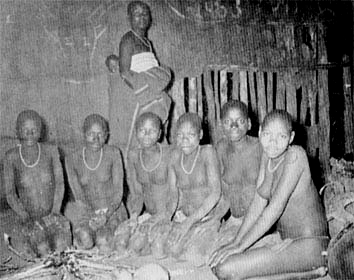|
|

Novices in the council hut learning the milayo.
Among the first milayo initiates learned were those referring to the council hut, where most of the dancing and instruction took place, and to which right of entry depended on knowing the milayo of the doorway. Each girl recited these milayo as she stood outside the entrance of the council hut, and both before and after the recitation she was made to kneel humbly (-losha). Their importance as passwords for entering the council hut was stressed by a master who said "Ni dzhena nga milayo" (you enter by means of the milayo). Two examples of such milayo, which were often performed in succession, are given below:
Call:
Tshiukhuvha (doorstep):
Response:
Tshankhukhu tsho khukhula khomba, thungamamu a i khukhulwi (the tripper has tripped up the maiden; the girl [with budding breasts] does not trip).
Call:
Ngeno (here, on this side):
Response:
Munzeru munzerula khomba, thungamamu a i nzerulwi (the stripper strips off the maiden; the girl is not stripped).
The first of these milayo was meant to teach that a mature woman should kneel whenever she entered the council hut; the other referred to the novice's new sexual roles.
|
|